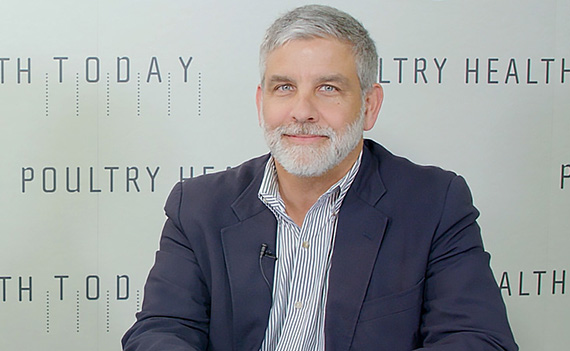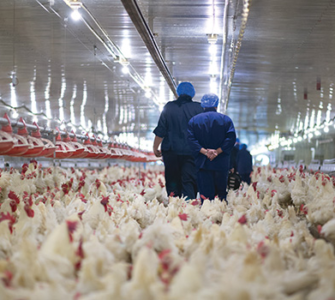Calcium toxicity cases underscore value of networking for knowledge
website builder By Philip A. Stayer, DVM, MS, ACPV
Corporate Veterinarian
Sanderson Farms, Inc.
Most chicken doctors refer to the Diseases of Poultry as the “bible of poultry disease,” but even this revered source of knowledge may be incomplete and can’t replace networking with colleagues. Just one such example is the clinical presentation of calcium toxicosis.
The 11th edition of the “bible” describes the signs of calcium toxicity as increased fecal water content and gross lesions on necropsy as nephrosis/urolithiasis, visceral urate deposits and upper digestive-tract epithelial necrosis. I’ve certainly observed these lesions, but I’ve also made several other observations not included in this description and perhaps not previously reported anywhere.
Toxicity in broiler breeders
One memorable experience with calcium toxicosis occurred in 2013 and involved broiler breeder hens. Mortality was mildly increased — exceeding 0.25% weekly — in one particular grow-out division. Supplemental vitamin D and oyster shell were given a few days once a month to improve egg shells. Hen mortality increased during this time, but then normalized within a few days after this supplementation stopped.
After some months of recurrent elevated hen mortality we conducted several pullet and hen mortality necropsy sessions as well as farm visits. In dead birds, we noted visceral gout in almost half of the natural mortality. Typically, we see perhaps one hen per 100 with visceral gout, not 50%. Of the 12 hen farms in the division, visceral gout was found on nine. Most of the birds with gout also had shrunken or missing parts of one or both kidneys. We also saw a few birds on each farm with kidney and liver tumors.
Histopathology of affected tissues yielded a variety of findings — mainly gout and lymphoid leukosis. There was no increase in infectious bronchitis titers on serology, nor were there any wrinkled shells, so viral causes for kidney damage were deemed unlikely. No mycotoxins were detected in tissues or feed for the mycotoxin panel selected. Suspect tumorous tissues were PCR-positive for Marek’s disease, but no viruses were found when virus isolation was attempted.
Overall, flock mortality in the hen house increased 2.29%. There was also decreased uniformity. The two main causes of elevated mortality included renal failure after calcium supplementation and highly probable Marek’s disease-causing tumors.
Delayed diagnosis
The diagnosis of calcium toxicity was delayed by the finding of tumors, which confounded the preliminary diagnosis — and because the feed analysis wasn’t carefully considered until after the fact. A retrospective check of the feed did, in fact, turn up aberrations.
Unaffected divisions tended to average about 0.81% calcium in pullet developer from 2002 to 2012, while the affected division exceeded 3% calcium for the 2011 and 2012 testing period. The affected division previously had similar 0.80% calcium for 2002 through 2010.
The most probable cause of the 2013 case of calcium toxicity was a formulation error. Three of the 12 hen flocks were unaffected within the same period because they received a different grower diet that was formulated with the typical 0.8% calcium to include Histostat for histomoniasis control. Likely there was a “copy and paste” error from the nutritionist’s computer that formulated the excessive calcium in the “normal” pullet feed.
Both feed-mill personnel as well as live-production personnel overseeing the division’s operations missed the dramatic formula change. Veterinarians did not monitor feed formulations or feed analyses until after there was a problem with increased mortality, since reviewing feed analyses is not in their occupational “lane.”
The 2013 case of increased hen mortality was fixed by adjusting calcium content in the pullet diet as well as increased Marek’s protection. Breeder mortality surveys were continued to document the benefit of both interventions.
Baby broilers case
My colleagues and I were presented with another unusual clinical case in 2014. It involved baby broilers. Elevated broiler-chick mortality was noted on four farms at around 2 weeks of age. The field report described small birds with decreased feed consumption, lethargy, depression, huddling and recumbency. Some of the affected animals were dyspneic.
Affected chicks were brought to a group of veterinarians conducting a routine posting session. Most of the sampled birds had some form of cardiovascular failure and many had severe ascites. No other serosal gross lesions were noted upon necropsy. When gizzards were opened, gizzard contents contained large particles of limestone.
Ingredient error
Upon investigation at the feed mill on location, this case of calcium toxicity was probably due to an ingredient error, not a formulation error. A load of large-particle limestone was mistakenly unloaded into the soybean meal bin. One of the feed-mill operators recognized the error and attempted to remedy the situation immediately, but apparently some large-particle calcium remained in the soybean meal and was in broiler starter feed that was delivered to eight houses on the four affected broiler farms.
To address the problem, the remaining contaminated feed on the farms was replaced with coarsely cracked corn (mash feed corn grind). My theory was that the large-particle limestone retained in gizzards would be displaced by large corn particles. However, there was no apparent benefit from the cracked corn, and there was a delayed return to normal broiler feed. Birds in the affected houses did not grow like the birds in the unaffected houses on the same farm. Apparently, broilers cannot catch up for lost growth that occurs earlier in their lives. Otherwise, there were no lingering effects of short-term, high-level coarse calcium.
Replacement pullets affected
Flash forward 4 years. On August 16, 2018, my colleagues and I walked two houses of 16-day-old pullets to investigate high-mortality and non-ambulatory pullets. The problems were even more evident in co-habited roosters. As reported, we found both males and females reluctant to move. Some birds were totally immobile. About one of 20 affected birds also had pasted vents indicative of diarrhea.
We necropsied dead and lame birds from all four of the houses on the farm and saw similar lesions in birds from each house. All birds had textbook gross lesions of phosphorous-deficient rickets (normal growth plate and wide zone of maturation) as well as large-particle limestone in their gizzards. Several but not all dead and cull birds had ascites.
Histological diagnoses of tissues sent to the regional veterinary laboratory included “mild expansion, moderate disorganization, zone of proliferation of growth plate (3/3). Moderate (2/3) to marked (1/3) expansion, hypovascularization, zone of hypertrophy of growth plate; focal chondrodegeneration (1/3); focal heterophilic osteomyelitis, osteolysis (2/3); heterophilic marrow hyperplasia (3/3).”
The pathologist commented, “Mild changes in the zone of proliferation of the growth plate and moderate to marked changes in the zone of hypertrophy are most consistent with a nutritional cause (phosphorous deficiency or mixed calcium, phosphorous imbalance).”
Another milling mishap
We recommended changing the feed, including emptying all feed lids and feed tracks of current feed to replace with fresh feed. No water-source interventions were recommended since excessive calcium release (water source vitamin D or other vitamin pack) would worsen the already adverse calcium-to-phosphorus ratio. There were no lingering effects of phosphorus-deficient rickets, judging by uniformity and bodyweight gain.
Further investigation revealed that like the 2014 case, there was not a formulation error but rather an ingredient error. Feed-mill staff said they’d noticed a leak in a pneumatic tube on the limestone supplier’s truck during unloading while the mill was simultaneously receiving corn.
Probably, the spilled limestone was swept or washed into the corn unloading pit and accounted for as “corn” in the corn silo. The “hot spot” of large-particle limestone stayed with corn during grinding, storing and mixing, and ended up in the final mixed pullet-starter feed, which is made exclusively for one farm at a time due to the low volumes required. If other flocks were exposed to this contaminated corn, there were no clinical signs reported to the veterinary team.
Summing up
Clinical presentations and underlying causes were different for three different episodes of calcium toxicity that we’ve documented in commercial meat-type chickens.1 The first case occurred in replacement breeding stock and was eventually recognized when mature hens died excessively after water-source vitamin D was administered for eggshell purposes. Gross lesions included visceral gout in dead hens and atrophic kidneys in immature pullets. Calcium toxicity was due to excessive calcium formulated in pullet feed.
The second case of calcium toxicity presented as elevated broiler mortality with ascites. Large-particle calcium was mistakenly loaded into the soybean bin at the source feed mill, and residual calcium particles were mixed into several batches of broiler starter feed.
In the third case involving replacement pullets, the initial observation was pullets that were reluctant to move. Upon physical examination, clinical phosphorus-deficient rickets was diagnosed. Large-particle calcium found in the gizzards of affected birds proved that an inappropriate calcium type was incorporated into rations for immature chickens.
These three cases document three different manifestations and causes of calcium toxicity in commercial meat-type chickens. The ”bible of poultry disease” continues to be my go-to source for most chicken disease information, but I am also likely to call my chicken network to see if anybody has already seen what I just saw.
Printed documentation is very helpful for all poultry veterinarians, both young and old, but it’s difficult for non-academic poultry veterinarians such as myself to devote the time necessary to write articles acceptable for publication in scientific journals. Thankfully, we have resources like the American Association of Avian Pathologists annual meeting. Although the meeting this year is virtual and we’ll miss the in-person contact, the program will still be a great source of contemporary information not yet available in journals and volumes such as Diseases of Poultry.
Editor’s note: The opinions and advice presented in this article belong to the author and, as such, are presented here as points of view, not specific recommendations by Poultry Health Today.
1 Stayer PA, et al. Three Times a Charm? Three Different Clinical Presentations of Calcium Toxicity in Meat Type Chickens. 156th Annual Convention of the American Veterinary Medical Association, Washington, DC; August 2, 2019.
Posted on May 15, 2021
















